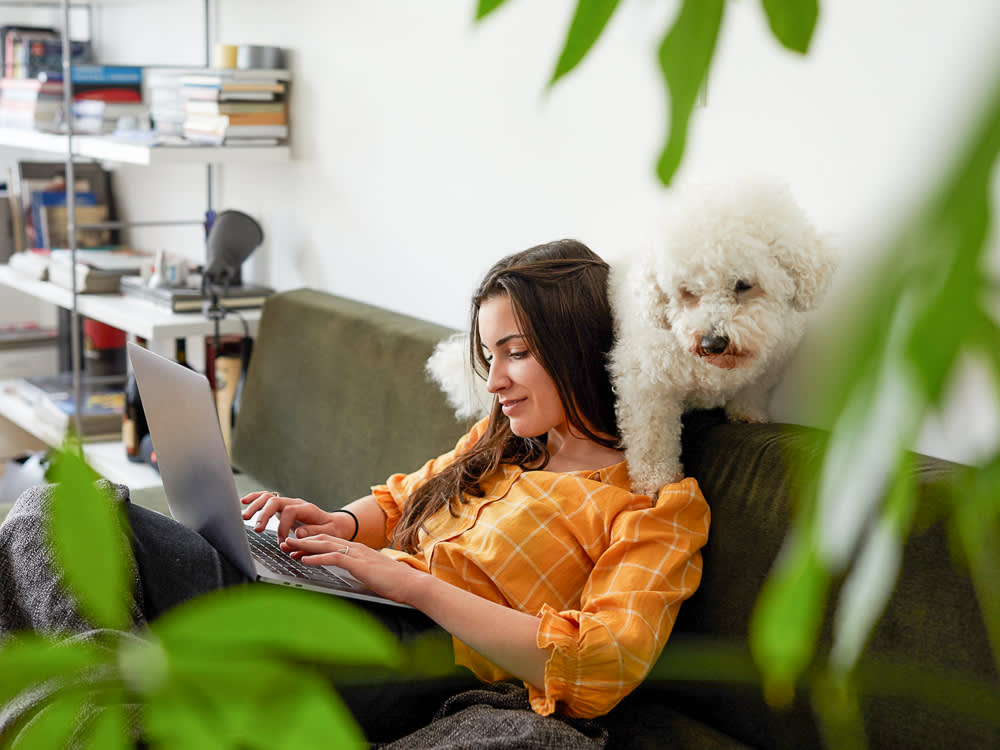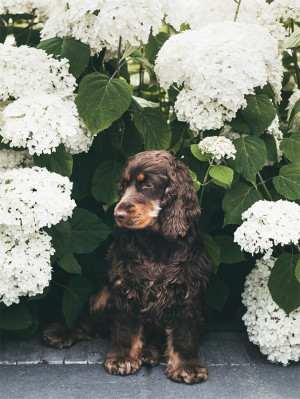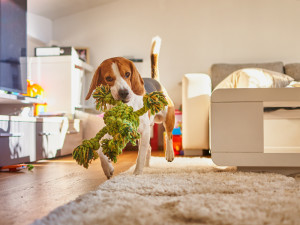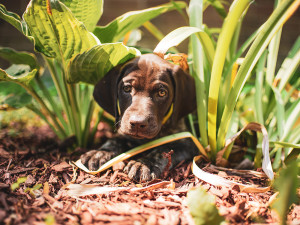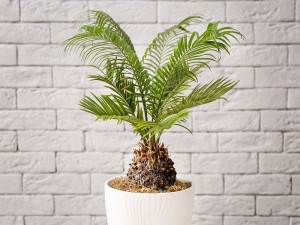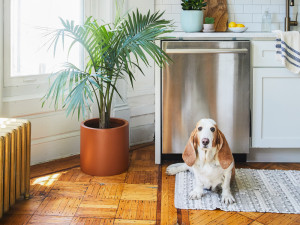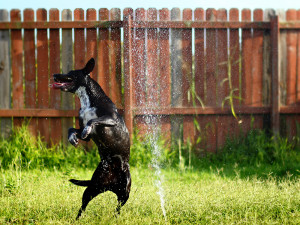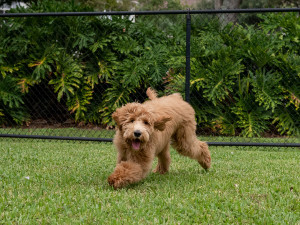The 10 Best Non-Toxic House Plants for Dogs
Brb, running out to buy air plants and succulents.
In This Article:
The 10 Best Dog-Friendly House Plants How to Keep Dogs out of House Plants Toxic Plants for Dogs What If You Suspect Your Dog Ate a Toxic Plant?
When adopting a new dog, there are a lot of things to worry about, like making sure your pup gets the right nutrition, attention, veterinary care, and training. But what about dog-proofing your home? You might be surprised to learn that some common houseplants, like peace lilies, are toxic to both dogs and cats.
According to the ASPCA, their poison control hotlineopens in new tab receives around 150,000 calls annually from pet parents needing assistance with possible poison-related emergencies. To help keep your pup healthy, make sure the plants in and around your home are safe for them. Here are the best dog-safe, non-toxic houseplants to get you started (and be sure to check out this handy listopens in new tab of toxic and non-toxic plants from the ASPCA).
The best dog-friendly plants
1. Spider plant
Chlorophytum comosum, commonly referred to as spider plants, are one of the most widely recognized and popular houseplants — and the good news is, they’re safe for dogs. These plants are popular for beginners because they are one of the easiest plants to care for. They don’t need a ton of attention and can thrive in almost any home. If you’re a novice looking for a pet-friendly starter plant, this should be your top choice.
2. Tillandsia
Commonly known as “air plants,” tillandsia are perfect for a home with pets: They are non-toxic to dogs, low maintenance, and very decorative. Because they do not require soil to grow, they can fit just about anywhere. Tillandsia are commonly used as stunning, living-art pieces displayed on shelves, driftwood, small urns, or hanging glass bulbs. Basically, they’re great anywhere your dog can’t reach them. But remember: Low-maintenance does not mean no-maintenance!
3. Boston ferns
Nephrolepis Exaltata, commonly known as the Boston fern, is a beautiful fern with a feather-like quality. True ferns like the Boston fern are typically non-toxic to dogs, and they make wonderful houseplants. These graceful, easy-care ferns make wonderful hanging plants or the perfect accent to the top of a bookshelf. They do best with indirect sunlight and moist soil.
4. Staghorn fern
These unusual plants have two types of leaves: one heart-shaped and one that looks like the horns of a deer (hence the name). They are non-toxic to both cats and dogs, and they are easy to grow if you provide the right living conditions. Typically, these unique plants will be found mounted on a wall or draping from a hanging basket.
5. Maidenhair fern
Similar to the Boston fern, maidenhair ferns (Adiantum sp) are soft, gorgeous ferns with a fan shape and feather-like quality. Some might consider maidenhair ferns to be finicky, but they can be easy to care for once you learn the trick: water, water, water! These plants love water so much that you practically cannot over-water them — add in a bit of bright light and you are set. These plants flourish in the right conditions, and because they are non-toxic to dogs and cats, they make a wonderful addition to any home.
6. Prayer plant
The Maranta plant (Maranta leuconeura), also known as the prayer plant, has a unique ability: Its oval-shaped leaves rise to an upright position during the night and fold together as if in prayer. These plants are easy to care for, do well in hanging baskets, and make for a great pet-safe houseplant.
7. Cat grass
Wheat grass, also known as pet grass or cat grass, is actually quite nutrient dense. It contains chlorophyll, fiber, vitamin E, phosphorus, magnesium, iron, and potassium, plus some protein and carotenoids. Wheat grass may also help pets with upset stomachs. It’s easy to grow and care for but does require clipping similar to a lawn.
8. Rosemary
Salvia rosmarinus, commonly known as rosemary, is an evergreen herb that is native to the Mediterranean. It requires a lot of sun (6-8 hours of full sun) and is sensitive to overwatering, so it can be tricky to care for indoors.
9. Ponytail palm
Beaucarnea recurvata, known as the elephant’s foot or ponytail palm, are easy to grow, provided you don’t overwater them. Kept indoors, they rarely get larger than four feet tall and can be started small and transplanted as they grow. Despite the name, the ponytail palm isn’t a true palm — it is actually a part of the agave family. The ponytail palm makes a wonderful large indoor plant that is dog-safe.
10. Blue bird
This rosette-style succulent is a gorgeous addition to any dog-loving home. It’s not too fond of the cold, so it’s perfect for indoors. Place it in a sunny location like a windowsill, and lightly water it to maintain its beautiful color.
How to keep dogs out of houseplants
Finding out your dog destroyed your favorite plant sucks, so here are some tips to help your dog cohabitate with your plants peacefully:
Keep plants elevated: Use items like bookshelves and plant hangers to place houseplants in areas that are too high for your dog to reach.
Provide alternative entertainment: Sometimes, boredom leads to naughty behaviors, so make sure your pup stays stimulated with toys, play time, and exercise.
Use deterrents: Use dog-safe deterrent sprays on and around plants to keep your dog uninterested in them.
Build a barrier: Strategically place furniture or other household items to block your dog’s access to plants. Or keep your plants in one room and use a baby gate to keep your dog out.
Turn to training: Train your dog to respect boundaries and use positive reinforcement to encourage good behavior around plants. Consistency and plenty of treats can help establish positive behavior around plants.
Toxic plants for dogs
Being a responsible dog parent means prioritizing your pup's safety. While bringing greenery into your home can promote a healthy environment and create a sense of peace, it's important to be aware of plants that pose a threat to your dog. Though this isn’t an exhaustive list, here are some common houseplants that dogs should steer clear of:
Sago palm (Cycas revoluta)
Lavender (Lavendula spp.)
Lemon grass (Cymbopogon citratus)
Jade plant (Crassula ovata)
Aloe vera
English ivy (Hedera helix)
Dumb cane (Dieffenbachia spp.)
Yew (Taxus spp.)
Snake plant (Sansevieria trifasciata)
Bird of paradise (Strelitzia reginae)
Dragon tree (Dracaena marginata)
Cutleaf philodendron (Monstera deliciosa)
What should I do if I suspect my dog has consumed a toxic plant?
If you suspect that your dog ingested an indoor or outdoor plant that is toxic, reach out to your veterinarian or an animal poison control center for immediate assistance. Be ready to provide details about the plant, the amount ingested, the part of the plant ingested (leaf, seed, flower, root), and any symptoms your dog may be exhibiting. Be prepared to take swift action, if recommended.
Have some vigilance when spending time outside with your dog. You can’t control what grows in the great outdoors, but make sure curious pups steer clear of toxic outdoor plants like sago palm, mushrooms, water hemlock, and azaleas.
FAQs (People also ask):
Is grass safe for dogs to consume?
Eating grass is a common behavior seen in dogs and usually does not cause any harm if done in moderation. Grass that has been recently treated with pesticides or fertilizers may pose a risk to dogs, though.
Are citronella plants safe for dogs?
Citronella plants usually refer to scented geraniums (Pelargonium spp.) that contain essential oils that are toxic to dogs. Symptoms include GI upset, muscle weakness, and lethargy.
Why do dogs eat houseplants?
Dogs may eat houseplants for many reasons, including curiosity, boredom, taste, and stomach upset. Dog parents should keep in mind that any plant can cause GI upset in dogs and implement safety measures as needed.
What if my dog ate a flower bulb?
Some bulbs are non-toxic to dogs while others like tulips and irises are harmful to dogs. If your dog ate a flower bulb from a known toxic plant, contact your veterinarian right away. If you’re unsure, refer to animal poison control.
